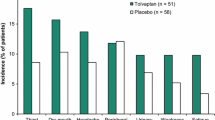Abstract
Objective: Determine the effect of low-dose theophylline on urine output and the urinary adenosine: cAMP (cyclic adenosine monophosphate) excretion ratio (a measure of phosphodiesterase inhibition) in diuretic-dependent critically ill children. Design: Observational clinical case series and animal laboratory experiment. Setting: A university pediatric intensive care unit and a pharmacology research laboratory. Patients: 10 consecutive oliguric patients treated with theophylline for diuresis. Interventions: Urine output, fluid intake, diuretic dosages, and number of pressors (including dopamine) were monitored over the 24-h period prior to and the 24-h period immediately after theophylline was started. Hourly collections of urine were obtained at baseline and 1 and 3 h after theophylline was started and urinary excretion rates of adenosine and cAMP were measured and calculated. Measurements and results: Mean theophylline level in the children was 5.0 μg/ml. Urine output increased from 1.58 ± 0.46 to 3.75 ± 0.77 ml/kg per h (p = 0.008, paired t-test) after theophylline administration. There was no significant change in fluid intake, vasoactive agents, or dosages of other diuretics during the study periods. Intrarenal infusion of the IC50 concentration of isobutylmethylxanthine for phosphodiesterase activity resulted in a reduction of the adenosine: cAMP urinary excretion ratio in rats (p < 0.05). Low-dose theophylline had no effect on the adenosine: cAMP urinary excretion ratio in children. Concurrent therapy with dopamine was associated with an enhanced diuretic effect of theophylline (with dopamine, 1.30 ± 0.30 to 5.07 ± 0.77 ml/kg per h vs without dopamine, 1.77 ± 0.76 to 2.86 ± 1.08 ml/kg per h; p = 0.03, two-way ANOVA). There was no interaction between dopamine and low-dose theophylline on the urinary adenosine: cAMP excretion ratio (p = 0.56, two-way ANOVA). Conclusions: Theophylline increased urine output in diuretic-dependent critically ill children and the diuretic effect may have been potentiated by concurrent use of dopamine. Adenosine receptor antagonism may be a more likely mechanism for the diuretic effect of theophylline than phosphodiesterase inhibition.
Similar content being viewed by others
Author information
Authors and Affiliations
Additional information
Received: 14 October 1997 Accepted: 9 July 1998
Rights and permissions
About this article
Cite this article
Bell, M., Jackson, E., Mi, Z. et al. Low-dose theophylline increases urine output in diuretic-dependent critically ill children. Intensive Care Med 24, 1099–1105 (1998). https://doi.org/10.1007/s001340050723
Issue Date:
DOI: https://doi.org/10.1007/s001340050723




